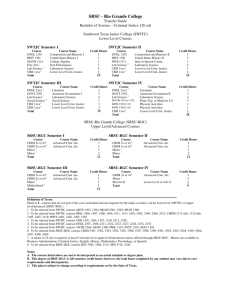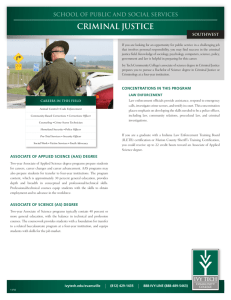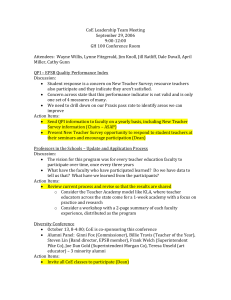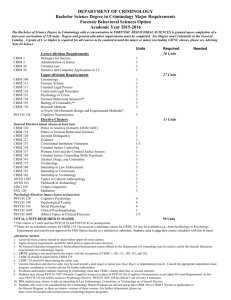Academic Program Review Report:
advertisement
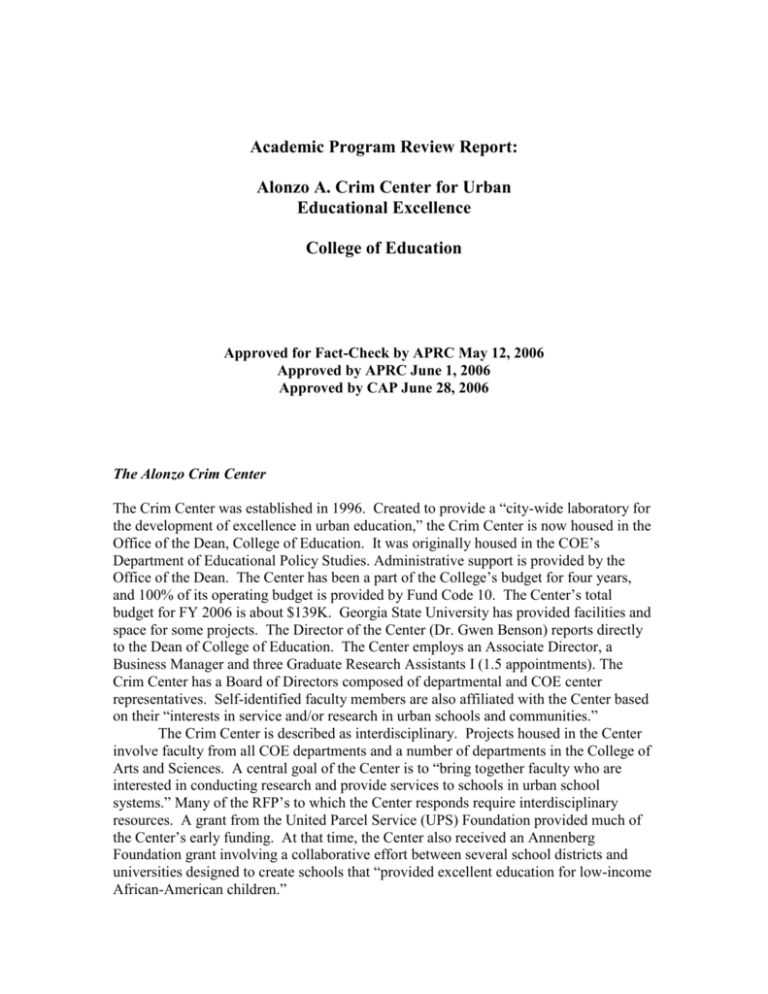
Academic Program Review Report: Alonzo A. Crim Center for Urban Educational Excellence College of Education Approved for Fact-Check by APRC May 12, 2006 Approved by APRC June 1, 2006 Approved by CAP June 28, 2006 The Alonzo Crim Center The Crim Center was established in 1996. Created to provide a “city-wide laboratory for the development of excellence in urban education,” the Crim Center is now housed in the Office of the Dean, College of Education. It was originally housed in the COE’s Department of Educational Policy Studies. Administrative support is provided by the Office of the Dean. The Center has been a part of the College’s budget for four years, and 100% of its operating budget is provided by Fund Code 10. The Center’s total budget for FY 2006 is about $139K. Georgia State University has provided facilities and space for some projects. The Director of the Center (Dr. Gwen Benson) reports directly to the Dean of College of Education. The Center employs an Associate Director, a Business Manager and three Graduate Research Assistants I (1.5 appointments). The Crim Center has a Board of Directors composed of departmental and COE center representatives. Self-identified faculty members are also affiliated with the Center based on their “interests in service and/or research in urban schools and communities.” The Crim Center is described as interdisciplinary. Projects housed in the Center involve faculty from all COE departments and a number of departments in the College of Arts and Sciences. A central goal of the Center is to “bring together faculty who are interested in conducting research and provide services to schools in urban school systems.” Many of the RFP’s to which the Center responds require interdisciplinary resources. A grant from the United Parcel Service (UPS) Foundation provided much of the Center’s early funding. At that time, the Center also received an Annenberg Foundation grant involving a collaborative effort between several school districts and universities designed to create schools that “provided excellent education for low-income African-American children.” The stated mission of the Crim Center is “ensure the availability of a prosperous and equitable school environment for children who are least served by urban schools by developing educational leaders, scholarly theory, and innovative strategies with a foundation built upon relevant knowledge and effective practice.” The COE’s Strategic Plan calls for the transformation of the Crim Center into “a research center with continuing outreach efforts.” The continuing goals of the Center are: Providing initiation, coordination and support for the funding of research projects on the individual, group and interdepartmental levels. Serving as a clearinghouse for the dissemination of scholarly information and the provision of technical assistance by a bank of experts. Securing and expanding sponsorship of the Crim Center. Hosting a biennial conference focusing on issues related to students and urban education. The Center’s performance is measured in terms of the outcomes achieved in relation to the goals listed above. The Crim Center and the COE have attracted external funding for important service-teaching programs focused on urban schools and urban education in amounts exceeding $10 million. These programs are aligned with and advance the service elements of the university’s strategic plan. Currently, the Center has eight projects/programs underway. These are: (1) urban teacher leadership, (2) Benjamin Mays Lecture Series, (3) Jumpstart, (4) Professional Development Schools, (5) Atlanta Housing Authority Project, (6) DREAMS, (7) Turner Teacher Scholars, and (7) MLK Curriculum Project. Over the past three academic years, the Center reports 26 funded projects, 7 of which are described as having a research component. The others are largely a combination of teaching and service activities. Observations 1. The Crim Center appears to have achieved its goal of attracting significant external funding for teaching and service activities related to urban schools and urban education. The Center report provides strong evidence of a major commitment to and investment in community service. It is clear that its energies have been invested in making important service-teaching contributions that are attractive to and supported by external sources, but there is little evidence in its report to suggest that this success has been paralleled on the research side. 2. In terms of the COE’s strategic commitment to research, the extent to which significant external funding for scholarly and applied research has been attracted is at best unclear and the Crim Center’s report suggests that its success to date in this area has been minimal. The Center’s report lists only two book chapters and two dissertations as publications that have resulted from the Center’s research activities in the past three years. 3. The Center’s report lists no faculty members other than the Director and Associate Director as being funded by the Center for the prior fiscal year. There is no indication of any faculty having received course releases or summer pay from external grants or contracts. The Principal Investigator for Center projects is consistently listed as the Director and/or Associate Director. This suggests that the Center is not funding COE faculty and/or faculty from other schools and departments through its portfolio of externally funded projects. (See addendum provided by the Crim Center below.) 4. As noted in the report, the Center has not succeeded in securing long-term sponsorship from external sources. 5. Crim is perceived by COE tenure track faculty as a service activity despite ongoing efforts to refocus its agenda on research. 6. The Center’s report offers little evidence of significant efforts or investments designed to refocus its goals and efforts to secure external funding for major basic and applied research projects. Recommendations 1. The COE may want to revisit its plan to transform the Alonzo Crim Center into a research center in light of its apparent success and value as a service center. If it does not, then the following recommendations should be implemented. 2. The Center, in light of its currently stated mission and research center goal, should take steps designed to greatly increase its research-based publication and reports output. 3. The Center should seek funding for basic and applied research that includes budget lines for course releases, summer buyouts, and other forms of support for research-oriented activities by faculty from COE and other colleges. This kind of support is necessary if the Center is to achieve its goal of being a genuine research center. This is also a critically important means of achieving long-term faculty “buy-in” and establishing a meaningful link between participation in Center projects and the promotion and tenure criteria of the colleges and university. 4. The Center should take steps designed to build its reputation as place where quality research is designed, executed, and disseminated widely. This should include support for the production of refereed publications, conference papers, and dissertations of scholarly note. Addendum Provided 5-26-06 Addendum to Academic Program Review Report: Alonzo A. Crim Center for Urban Educational Excellence Below is evidence that research-based products are emanating from the external funding that has been attracted to the Alonzo A. Crim Center. Professional Development Schools: Professional Development Schools (PDSs) are partnerships that offer opportunities for Georgia State University and pre K- 12 schools to join together to foster the evolution of unique sites where school and university have the shared goal of enhancing the education of professionals through a serious commitment to collaboration. PDS partnerships have a four-fold mission: the preparation of new teachers, faculty development, inquiry directed at the improvement of practice, and enhanced student achievement Georgia State University faculty involved in research funded by the PDS grant: Faculty Department Susan Swars ECE Amy Slack MSIT Julie Dangel ECE Dana Fox MSIT Stephanie Smith ECE Susan McClendon CUEE Valerie Miller Math (College of Arts and Sciences) Mary Deming MSIT Brendan Calandra MSIT Bill Curlette EPS Laurie Dias MSIT Melody Milbrandt Music George McMahon EPSE PRISM (Partnership for Reform in Science and Mathematics) is a National Science Foundation (NSF) funded program that aims to improve statewide achievement in science and mathematics. It is a comprehensive program created to ensure that elementary, middle and high school students are taught science and mathematics by highly qualified, diverse teachers and to develop a statewide “best practices” approach to teaching and learning science and mathematics. The program aims to create collaborations between classroom teachers and science and mathematics faculty at Georgia State University. Georgia State University faculty involved in research funded by PRISM: Faculty Department Christine Thomas Nadia Hanna Lynn Hart Kathryn Kozaitis Valerie Miller Olga Jarrett Becky Patterson Draga Vidakovic 15 Graduate Research Assistants MSIT MSIT ECE Anthropology (College of Arts & Sciences) Math (College of Arts & Sciences) ECE MSIT Math (College of Arts & Sciences) Early College at the New Schools of Carver-Atlanta Public Schools National studies show that students perform better in smaller, more personalized settings; therefore each school is designed as an independent school that offers students the opportunity to attend a high school that matches their interests and allows them to make real-world career connections. The new campus at Carver includes five individual high schools that will prepare graduates for success in the 21st century by having a rigorous academic program, state-of-the-art facilities and dynamic community partnerships. Early College at the New Schools of Carver is a collaboration between Atlanta Public Schools, Georgia State University and the Bill and Melinda Gates Foundation. Students enrolled in Early College have the opportunity to graduate from high school with 60 hours of college credit. All students, at a minimum, sample college-level courses through advanced placement courses or a dual enrollment program. Georgia State University faculty involved in research funded by Early College: Faculty Department Mary Deming MSIT Kim White EPS


![Independent Study Guidelines and Instructions[1]](http://s3.studylib.net/store/data/007234727_2-8b8411c8bd9ef998d40d498e693eb9a3-300x300.png)

